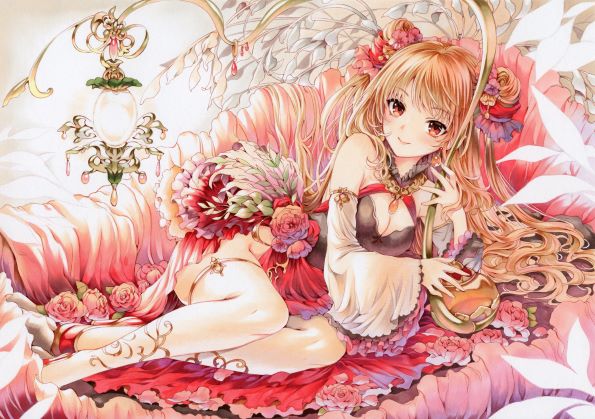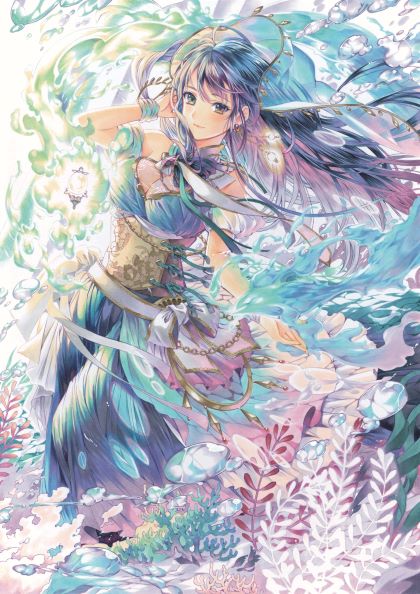一発勝負のアナログ着色どうしたらいい!?「コピックアワード2020」受賞者ymにコツを聞いた

構成/原田イチボ@HEW
アルコールマーカー「コピック」の世界は奥深い……。多彩に展開されるカラーをさらに混色させることによって、その色数は無限といっても過言ではありません。とはいえ、なかなか思うように使いこなせていない人もいるのではないでしょうか。
コピックで素敵なイラストを描くコツとは? 練習の上で意識すると良いことは? コピック公式作品コンテスト「コピックアワード2020」でpixiv賞を受賞したymさんに、初心者が気になるアレコレを教えていただきました。
ネットオークションでイラストを販売する異色の経歴
── 受賞作『海のまほろば』ですが、あまりの緻密さに驚きました。こちらはコピックを何色くらい使って描かれたものなのでしょうか?

4、50本くらいです。
── 制作時間はどのくらいかかりましたか?

申し訳ないのですが、「コピックアワード2020」の存在を知ったのが〆切の1週間前だったんです……。もう少し余裕を持って制作できればよかったなと、そこだけは今でも後悔しています。
── 1週間で、このクオリティとは……! イラスト歴は何年くらいですか?

落書き程度は小さい頃からしていました。本腰を入れてイラストを制作するようになってからは10年経っていないくらいですかね。イラストをもっと頑張ってみようと思ったのは、姉の影響です。姉がイラストをずっと描いていて、コピックも最初は姉からもらったんですよ。

── 商業の場でイラストを描いた経験は?

ありません。完全に趣味の状態でずっと描いていました。
古賀:「コピックアワード2020」を担当しているpixivの古賀です。実はymさんの応募作品を見て、コピックの関係者の方々が「この人は誰!?」とざわめいたんですよ。というのもコピックの中の人たちって、コピックを使うイラストレーターさんのことをかなりチェックしているんです。でもymさんは商業の場でもファンアートの場でも活動の形跡が見当たらなくて、「こんな描き手の方がいたのか!」と驚かされました。「コピックアワード2020」の「描き手を発掘する」というコンセプトからしても、ぴったりの受賞者でした。

恐縮です。あっ。でも実はネットオークションサイトでイラストを売っているんですよ。「手描きイラスト」というのがカテゴリとして存在しているんです。「在宅でもお金を得られる手段ってなんだろう?」と考えたときに思い浮かんだのが自分のイラストを売ることでした。そういう意味で、イラストでお金を得る活動はしています。
── たしかに「手描きイラスト」というタグ、存在する! とはいえ、なかなか珍しい経歴ですね。「コピックアワード2020」には、なぜ応募したのでしょうか?

姉から薦められました。それで、漫画家の小畑健先生が審査員のひとりだと知って、「やってみたい!」と決めました。小さい頃から小畑先生が大好きなんです(笑)。でも受賞どころか入選するとさえ思っていなかったので、すごくびっくりしています。姉が私より喜んでくれたのがうれしかったです。
── ちなみにお姉さんの結果は……?

姉は〆切に間に合いませんでした(笑)。
画用紙? 水彩紙? 紙選びは奥が深い世界
── 受賞作『海のまほろば』のコンセプトを教えてください。

エントリー時期が夏だったので、夏といえば海かなと。海となると寒色系が思い浮かびますが、もうちょっと冷たすぎない感じというか、夏の海らしさを表現したいと思いました。全体としては寒色を使いながらも、爽やかさと同時に温かみを出すことに挑戦しています。
── 先ほど「〆切の1週間前に『コピックアワード2020』を知った」とおっしゃっていましたが、制作スケジュールはどのようなものだったんでしょうか?

ラフに2日、線画に1日半、残りは塗りです。
── ということは、着色には3日程度しか掛かっていない。

大体いつもそのくらいのペースですね。インクが乾ききらないうちに、塗るときは一気に済ませちゃいます。そのぶん、離れて見たときにバランスが悪くならないように、画面をどう埋めるかはきっちり決めておきたいので、ラフには時間をかけます。
── 原画のサイズはどのくらいですか?

A4です。
── そのサイズで、この緻密さとなると、原画はかなり迫力がありそうですね。紙に何かこだわりはありますか?

あまりこだわりはありませんが、普段は画用紙にイラストを描くことが多いです。画用紙は色が濃く出て、「バーン!」とした発色になるんですよ。逆に水彩紙だとグラデがきれいに出るんですが、そのぶん滲みやすいので、細かく描き込みたいときには向かない気がします。受賞作はコピックの特選上質紙を使いました。薄い色がきれいに乗るので、淡いテイストのイラストにしたいときは良さそうですね。紙の選び方は奥が深い世界だと思います。私も普段からいろいろな紙に試し書きして、向き不向きを知るようにしています。
── そういえば過去作の中には、パキッとした色使いのイラストもありましたね。あれは画用紙ですか?


ymさんが過去に描かれた作品

── 「なんで塗りムラがないんだ!?」と驚きました。

そこはもうインクが乾かないうちに手早く塗るのみです(笑)。それでもムラができた場合は、色鉛筆を使ってムラを消しています。失敗したときのリカバリは、大体、色鉛筆でなんとかしています。コピックだけで何とかしようとしたら、色が分離(顔料の粒の大きさの違いによって、色同士が分かれて見えること)したりして、逆に事態が悪化する場合もあるので……。
── アナログだと失敗のリカバリが難しいので、ありがたい情報ですね。受賞作だと、キャラクターの頬の赤みも後から色鉛筆で乗せているのでしょうか?

はい、そうです。
── 他にコピック以外で使っている画材はありますか?

あとはホワイトくらいですね。ただ、ホワイトは修正というより、瞳のハイライトなど、光を表現するために使っています。オークションでイラストを売る場合、修正は落札者さんにあまり好かれませんので……。
「色のエリア」を決めたら全体の統一感が生まれる
── 配色はどうしても一発勝負になってきますよね。事前にどれくらい決めるものなのでしょうか?

「コピックアワード」でも作品のキーカラーというものがありましたが、そのイラストのテーマになる色を最初に3色くらい決めるようにしています。たとえば、赤でスカートを塗るとなったとき、ついスカートの影は濃い赤で塗りたくなるじゃないですか。でも同じイラストの別の部分で青い色を使って、そこの影は濃い青で塗るとなると、イラスト全体で見るとちぐはぐな印象になりかねません。そういうときは、影を赤紫や青紫で塗るだけで、ぐっと全体の統一感が生まれます。最初にキーカラーを決めておくことで、「細かい部分で何色を使えばいいか」のようなことが見えてくるんです。コピック初心者の方でも、たぶん最初にキーカラーを決めるだけで、一気にイラストの見栄えが変わるのではないでしょうか。
── たくさんの色を使っても統一感のあるイラストにするテクニックはありますか?

色のエリアを決めることですね。
── 色のエリア?

1枚のイラストを「左上半分」「右下半分」のように分けて考えるんです。たとえば今回の受賞作で言うと、左上は黄色い光で、右下は青い光で、よく見たら1枚の中で結構違う色を使っていますよね。「このエリアは、この色」「反対のエリアは、この色」と最初に決めて、反対のエリアに近づくにつれて、そのエリアの色を増やしていくんです。あとは、作業中に時々絵を離して見て、全体のバランスをチェックすることが大切ですね。
── 離して見たとき、まとまりがなく感じた場合はどうすればいいでしょうか?

初めから私は薄い色から塗るようにしているんですよ。後から薄くすることはできませんが、後から濃くすることはできるので。だから、「ちょっと違うかな」と感じたら、濃い色を塗る段階で調整します。
── 塗り始める時点で、頭の中でどのくらい完成形が見えているものなのでしょうか?

一応、大体の配色は決めた状態で塗り始めます。でも、ガチガチに決めすぎてしまうと、塗っているうちに「違うかな」と思ったとき、一気に詰まってしまいかねません。だから、「違ったら違ったで、それも込みで塗り進めよう」と考えるようにしています。細かい部分で失敗してしまったときは、すぐに修正しようとするより、全体で調整していくほうが結果的に上手くいったりするんですよね。実は、受賞作も本当はもっと濃い青と紫が多くなる予定でした。でも塗っている中で、温かみが足りないと感じて予定変更しました。
── コピックはやり直しが効かないぶん、どこまで最初に決めて、どこまで塗りながら考えていくかのバランスが難しそうですね。

頭の中で塗る順番をきっちり決めるというよりは、経験だと思います。私も失敗してダメにしてしまった絵が今まで結構ありますから(笑)。
アナログ作画は「偶然」が楽しい
── 初心者が最初に躓きがちなポイントですが、グラデーションはどのように塗っていますか?

私の場合は濃い色から塗って、薄い色で伸ばしていくようにしています。
── 薄い色から塗る派もいますが、ymさんは濃い色から塗る派なんですね。

自分はこちらのほうが合っています。淡い色のグラデを作るときは薄い色から塗ることもありますが、大体は濃い色からです。色が段々になってしまわないように、先に塗ったところにかぶせるというか、上書きするようなイメージで塗っていますね。
── 「初心者は最初にこんな練習をすると良い」ということはありますか?

まずニブ(ペン先)に慣れることが大事だと思います。コピックは普通のカラーマーカーに比べると値段が高いですし、どうしても「ちょっとずつ大事に使おう」と思ってしまいがちなんですが、ニブに慣れるためにどんどん描いていったほうが良いと思います。
── ymさん自身が練習の上で気をつけていたことは何でしょうか?

練習でも1枚絵を最後まで完成させるようにはしていました。あと練習とは少し違いますが、ネットオークションで週に1、2枚はイラストを出品するように決めているので、コンスタントに絵を描き続ける環境ではあります。
── お金をもらう環境だと、妥協はできませんね。

クオリティが甘いと、落札者さんにガッカリされてしまいますので。あとネットオークションという環境では、お客さんの好みを伝えられることも多くあります。お金を出してイラストを買っていただく以上、そのリクエストに対して、「それは無理です」と即答はしづらいですよね。もちろん、極端に露出度が高いものなどは困ってしまうのですが、「ピンクを基調にしたイラストにしてください」のようなリクエストだと、いったん頑張ってみるようにしています。

ymさんが過去に描かれた作品
── 「こういうキャラで」ではなく、「こういう色で」というリクエストもあるんですね。なんだか、お客さん側のイラストに対する意識も高そうです。

今の時代に1枚絵を買ってくださる方々なので、イラストへの関心が高いぶん、自分のこだわりや感想をしっかり伝えてくれます。評価してくださる方が多いと、こちらの創作意欲も上がっていきます。落札価格というはっきり見える評価がある環境だからこそ成長できた部分もあると思います。
── コピックを使ってイラストを描くとき、根気とセンスのどちらが重要だと感じますか?

色選びはセンスですね。でも自分が表現したいものを描き上げるためには、最終的には根気が一番大切だと思います。理想はどこまでも突き詰めていけますから。
── 色選びはセンスとおっしゃいましたが、そのセンスを伸ばすためには何をすればいいと思いますか?

自分の場合、日常生活の中で気に入った色は覚えておくようにしています。「こういう風景、良いな」とか「この色合い、良いな」と感じたときは、「コピックで言うと、この色かな?」と早めにメモに残しています。とはいえ、私はそんなに色選びには自信があるほうではないですし、実際の作業中はこまめに試し塗りをして、色同士の見え方をチェックしたり、自分のイメージ通りの色がどれか追求したりすることも大事ですね。
── それもまた根気ですね。デジタルの経験はありますか?

ちょっとはデジタルもやりますが、家のパソコンがもう古くて、レイヤーを5枚くらい重ねると、「バン!」となって使えないんですよ(笑)。もともとはデジタル派だったんですが、今はアナログのほうが楽しいです。イラストの実物が存在するところが面白いし、簡単にやり直せない緊張感や、手作業ならではの温かみもある。あとデジタルは、自分の頭の中にあるものをそのまま表現するのに向いていますが、アナログだと、自分の想像していなかったものが生まれることもあります。今は描き手として、そういう偶然を楽しんでいます。
「コピックアワード2020」その他の受賞作はこちら!
第3回目となったコピックアワード2020。なんと世界各国から4321点もの作品が集まったのだとか。
ymさんをはじめ、素晴らしい作品ばかりなのでこちらもぜひチェックしてみてください!

